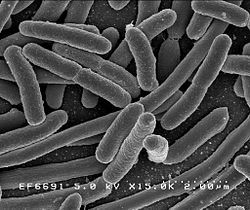Science News
E. coli Evolution

Every day for the past 25 years, Richard Lenski and other scientists at Michigan State University have been growing bacteria. Every day. Twenty-five years. That’s more than 56,000 generations of Escherichia coli, or E. coli. And it’s been a great way to study evolution.
The experiment demonstrates natural selection at work. And because samples are frozen and available for later study, when something new emerges, scientists can go back to earlier generations to look for the steps that happened along the way.
Last month, Zachary Blount, Lenski and colleagues published a paper in Nature detailing a new evolution in E. coli—the ability to eat citrate.
Shannon Bennett, associate curator of the Academy’s Microbiology department, explains why this is so unusual.
E. coli doesn't normally eat citrate unless it is desperate (there’s no glucose, no oxygen). But these E. coli did evolve the ability to eat citrate, in fact thrive on it, in the presence of both oxygen and glucose.
They were able to evolve to do this when certain individuals made mistakes and copied their citrate gene (which usually is turned on only under oxygen-poor conditions) to a different spot in the genome near a switch point that turns on in the presence of oxygen.
Blount was able to trace this new trait through generations and uncover a three-step process in which the bacteria developed this new ability.
The first stage was potentiation, when the E. coli accumulated at least two mutations that set the stage for later events (see Shannon’s explanation above). The second step, actualization, is when the bacteria first began eating citrate, but only just barely nibbling at it. The final stage, refinement, involved mutations that greatly improved the initially weak function. This allowed the citrate eaters to wolf down their new food source and to become dominant in the population.
“We were particularly excited about the actualization stage,” Blount says. “The actual mutation involved is quite complex. It re-arranged part of the bacteria's DNA, making a new regulatory module that had not existed before. This new module causes the production of a protein that allows the bacteria to bring citrate into the cell when oxygen is present. That is a new trick for E. coli.
“It wasn't a typical mutation at all, where just one base-pair, one letter, in the genome is changed,” he continues. “Instead, part of the genome was copied so that two chunks of DNA were stitched together in a new way. One chunk encoded a protein to get citrate into the cell, and the other chunk caused that protein to be expressed.”
Shannon explains why this study is so exciting:
This study is cool because it shows many of the important mechanisms in evolution, namely gene duplication and gene regulation (turning genes on and off at different times). It all went on in a series of test tubes, so it’s “artificial” evolution, but what's nice about that is, they were able to freeze samples down at early time points through to the present, to trace the path of evolution, and that they used a model organism, Escherichia coli, that evolves very quickly (not as quick as viruses, but much faster that vertebrates). My work takes advantage of the same historical sampling and evolutionary speed, only I've focused on “natural” experiments in the viruses I work on.